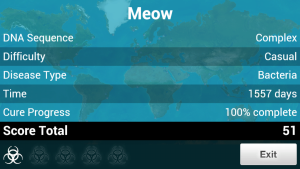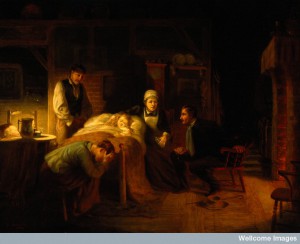Bacteria Name: Meow
Start date: October 14, 2015
Origin: Central Africa
100 people infected: around 47 days
1,000,000 people infected: around 2 months
First death: December 12, 2016 in East Africa
Destroyed human race?: No
If not how long: Cure research began in central Africa 5 months later. Cured at 1557 days
In the first game I concentrated on evolving the abilities of the bacteria Meow. The abilities of Meow were maxed out. I believed that maxing out these abilities will prevent researchers from making a cure because once there is a cure it is basically game over. My next area of concentration was the symptoms. I worked on making the symptoms as severe as I could with the amount of DNA points that I could obtain. By making the symptoms severe I thought that I could wipe out as many people and as fast as I could. As the game progresses it becomes harder to get DNA points because the game has reached a point of equilibrium. The cure research is ongoing and the amount of people dying and becoming infected is stable. This first game took quite some time to end. Ultimately a cure was made and Meow was eradicated. One of the main reasons I noticed was because I was unable to infect Greenland. All the methods of transmission to Greenland were shut down before I could get them infected. Therefore the cure was ongoing throughout the game. It was only a matter of time before the cure was made and the game was over.
Bacteria Name: Meow 2
Start date: October 14, 2015
Origin: U.S.A.
100 people infected: around 60 days
1,000,000 people infected: around 4 months
First death: around 6 months
Destroyed human race?: Yes
Meow 2 eliminated all of human race in 544 days. I took on a different approach for Meow 2. Because I was unable to infect Greenland in the previous game I concentrated on leveling up the transmission abilities for Meow 2 earlier on in the game. By doing so I was able to infect the entire world before the airports and docks shut down. At the same time, cure research began much earlier for Meow 2. Therefore, I evolved the abilities in Meow 2 as well to prevent quick progress in finding a cure. This method allowed me to counteract the containment and cure for Meow 2. The infection rate for Meow 2 was slower at first compared to Meow, but eventually picked up and multiplied rapidly. I believe that in order for a disease to spread the method of transmission is crucial to how diseases become a pandemic. In healthcare, one of the most important things we learn is all the preventative measures against transmission of diseases. By having a comparison of Meow vs. Meow 2, I can see that even if the disease is deadly, it won’t cause as much damage as long as it is contained. Meow 2 was not contained and eliminated the human race. Knowing the method in which bacteria is transmitted is important in preventing the spread of a disease.






